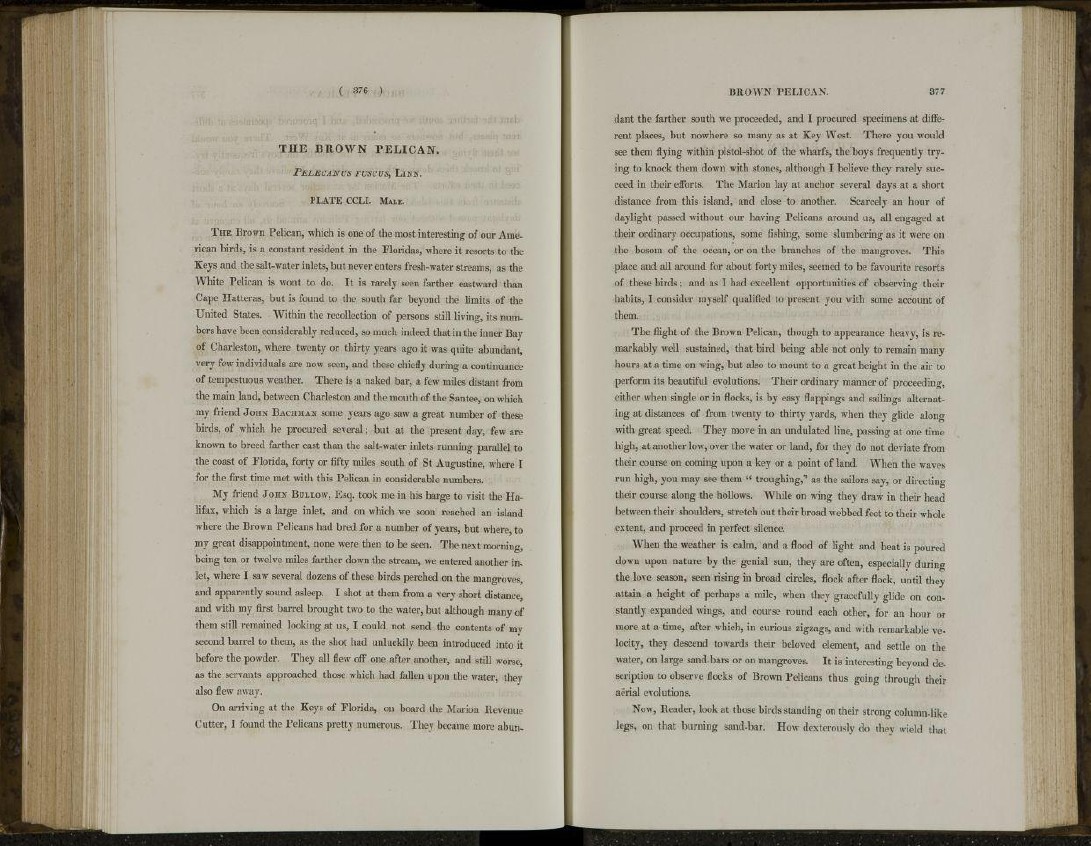
THE BROWN PELICAN.
PELECANUS FUSCUS, LINN.
PLATE CCLI. MALE.
T H E Brown Pelican, which is one of the most interesting of our American
birds, is a constant resident in the Floridas, where it resorts to the
Keys and the salt-water inlets, but never enters fresh-water streams, as the
White Pelican is wont to do. It is rarely seen farther eastward than
Cape Hatteras, but is found to the south far beyond the limits of the
United States. Within the recollection of persons still living, its numbers
have been considerably reduced, so much indeed that in the inner Bay
of Charleston, where twenty or thirty years ago it was quite abundant,
very few individuals are now seen, and these chiefly during a continuance
of tempestuous weather. There is a naked bar, a few miles distant from
the main land, between Charleston and the mouth of the Santee, on which
my friend JOHN BACHMAN some years ago saw a great number of these
birds, of which he procured several; but at the present day, few are
known to breed farther east than the salt-water inlets running parallel to
the coast of Florida, forty or fifty miles south of St Augustine, where I
for the first time met with this Pelican in considerable numbers.
My friend J O H N BDLLOW, Esq. took me in his barge to visit the Halifax,
which is a large inlet, and on which we soon reached an island
where the Brown Pelicans had bred for a number of years, but where, to
my great disappointment, none were then to be seen. The next morning,
being ten or twelve miles farther down the stream, we entered another inlet,
where I saw several dozens of these birds perched on the mangroves,
and apparently sound asleep. I shot at them from a very short distance,
and with my first barrel brought two to the water, but although many of
them still remained looking at us, I could not send the contents of my
second barrel to them, as the shot had unluckily been introduced into it
before the powder. They all flew off one after another, and still worse,
as the servants approached those which had fallen upon the water, they
also flew away.
On arriving at the Keys of Florida, on board the Marion Revenue
Cutter, I found the Pelicans pretty numerous. They became more abundant
the farther south we proceeded, and I procured specimens at different
places, but nowhere so many as at Key West. There you woidd
see them flying within pistol-shot of the wharfs, the boys frequently trying
to knock them down with stones, although I believe they rarely succeed
in their efforts. The Marion lay at anchor several days at a short
distance from this island, and close to another. Scarcely an hour of
daylight passed without our having Pelicans around us, all engaged at
their ordinary occupations, some fishing, some slumbering as it were on
the bosom of the ocean, or on the branches of the mangroves. This
place and all around for about forty miles, seemed to be favourite resorts
of these birds; and as I had excellent opportunities of observing their
habits, I consider myself qualified to present you with some account of
them.
The flight of the Brown Pelican, though to appearance heavy, is remarkably
well sustained, that bird being able not only to remain many
hours at a time on wing, but also to mount to a great height in the air to
perform its beautiful evolutions. Their ordinary manner of proceeding,
either when single or in flocks, is by easy flappings and sailings alternating
at distances of from twenty to thirty yards, when they glide along
with great speed. They move in an undulated line, passing at one time
high, at another low, over the water or land, for they do not deviate from
their course on coming upon a key or a point of land. When the waves
run high, you may see them " troughing,"" as the sailors say, or directing
their course along the hollows. While on wing they draw in their head
between their shoulders, stretch out their broad webbed feet to their whole
extent, and proceed in perfect silence.
When the weather is calm, and a flood of light and heat is poured
down upon nature by the genial sun, they are often, especially during
the love season, seen rising in broad circles, flock after flock, until they
attain a height of perhaps a mile, when they gracefully glide on constantly
expanded wings, and course round each other, for an hour or
more at a time, after which, in curious zigzags, and with remarkable velocity,
they descend towards their beloved element, and settle on the
water, on large sand-bars or on mangroves. It is interesting beyond description
to observe flocks of Brown Pelicans thus going through their
aerial evolutions.
Now, Reader, look at those birds standing on their strong column-like
legs, on that burning sand-bar. How dexterously do they wield that